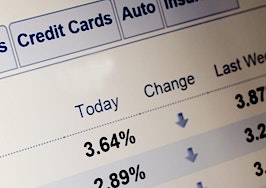- When global risk rises, money flows to the yen.
- For the first time since the Federal Reserve began to release its meeting minutes a dozen years ago, this most recent set is dominated by concern for the outside world.
- A quick scan overseas: Europe is either in or close to real deflation, resistant to the ECB’s massive bond-buying. Same in Japan but worse, negative rates causing more panic than help in its demographic implosion. China is of course the whale, its internal tinkering unsustainable but keeping the show going for now.
Long-term rates fell last week — only about one-eighth of 1 percent, but when the world is so close to zero or below it, any drop seems big. The 10-year T-note settled just under 1.75 percent, and low-fee mortgages near 3.75 percent.
The cause, again: trouble overseas.
Other markets — stocks, currencies, commodities — continued a new-age pattern increasingly prevalent. Global trading today is dominated by computers diddling each other.
One-third of Goldman employees are IT dweebs who don’t know a euro from a Yugo but can make a ton of money trading math, so long as economic fundamentals stay within the range of recent history.
Thus, we see every day the truly idiotic tail-chasing of oil by global stocks, and perhaps the all-time silliest self-perpetuator: When global risk rises, money flows to the yen. Why anyone would see the yen as a safe haven is beyond me. Mathematical habit and arcane currency “carry-trading,” but on the yen trade goes without significance.
Meanwhile, financial media desperate for an eyeball-attracting story every fifteen minutes shout that yen-stocks-oil-whatever suddenly indicate perpetual peace and freedom or Armageddon. Which makes it damned hard to locate substance.
Back in the day of “newspapers,” and diligent TV news anchors (Cronkite, MacNiel, Lehrer…), editors filtered news for substance. Today, the attention span of the audience has shortened to 144 characters, satisfied by a cacophony of “Look at the birdie!”
I still cringe at the memory of history professors insisting on original sources — what Lincoln actually said, not what some guy said that he said. In finance today, the closest we can get to original sources are the actual non-masticated stream of data, and the words of the primary actors: the central banks themselves. The world lives on central-bank life support, so listen to the docs.
Last week we got minutes of the Federal Reserve’s March meeting, and more speeches by senior officials. For the first time since the Fed began to release minutes a dozen years ago, this set is dominated by concern for the outside world. Evans (Chicago) delivered a professional beauty, and Rosengren (Boston) supported. We can neatly divide the thinking of those at the Fed who know there is an outside world, and those who don’t (KC’s George, SF’s Williams, Cleveland’s Mester).
The IMF (International Monetary Fund) is also an attending physician and last week very much out of character, issuing warning after warning. Its prior culture has been never to alarm the family or to expose locals as quacks.
[Tweet “The #IMF’s prior culture has been never to alarm the family or to expose locals as quacks.”]
The IMF has given us a new term, which gets to the heart of the Fed’s difficulty and change in policy in the last 60 days. The Fed has been aware of the hazard to the U.S. of a strong dollar pushed up by Fed tightening while everyone else is in ICU with a central-bank cash IV. That’s been known as a “spillover” effect, crimping our exports, and imports undercutting domestic production.
Last year, without anyone particularly noticing, an unnamed IMF staffer stumped a Fed governor by asking about policy spillbacks. The IMFer then explained, helpfully. If the Fed tightens in a way damaging to external economies — for example wrecking those who have borrowed dollars — the resulting global distress can do a great deal more harm here than just a strong dollar crimping our exports. Spillback.
See January’s global market upset, and a dead stop to the Fed.
A quick scan overseas: Europe is either in or close to real deflation, resistant to the European Central Bank’s massive bond-buying. Quantitative easing worked here, not there — the euro is crushing. Same in Japan but worse, negative rates causing more panic than help in its demographic implosion. Thus the yield on German 10-year bonds fell to 0.090 percent this week, and Japan’s to -0.083 percent. Minus. Fed or no Fed, those markets were the primary pull-down on U.S. mortgages this week. China is of course the whale, its internal tinkering unsustainable but keeping the show going for now.
Look outward, look outward, suspicious of sources.

US 10-year T-note five years back shows persistent bottoms close to where we are now.
U.S. 10-year T-note five years back shows persistent bottoms close to where we are now.

The Fed-sensitive 2-year T-note, the chart one year back, says maybe one more hike this year.
The Fed-sensitive 2-year T-note, the chart one year back, says maybe one more hike this year.

The winter spike in core PCE is already fading.
The winter spike in core PCE is already fading, but if it breaks out the Fed will tighten quickly, spillbacks or no spillbacks.

The Fed funds futures market has been wrong more often than right in the last decade, but its current values match the deadly serious trading in the 2-year T-note.
The Fed funds futures market has been wrong more often than right in the last decade, but its current values match the deadly serious trading in the 2-year T-note. Never has there been a gap remotely this wide between Fed jawbone and markets. And markets are winning:

Charles Evans’ version of the damned dots forecasting Fed action.
Charles Evans’ version of the damned dots forecasting Fed action. Evans, president of the Chicago Fed is one of the very best thinkers, and here reveals his own dots among the anonymous. He is much more reflective of Yellen’s intentions than the dim-brained hawks sitting on wires above his:

Above is a simple schematic for optimizing H2 production in a hydrogen generation system.
Above is a simple schematic for optimizing H2 production in a hydrogen generation system.
Lou Barnes is a mortgage broker based in Boulder, Colorado. He can be reached at lbarnes@pmglending.com.





